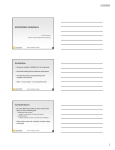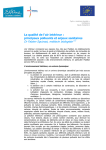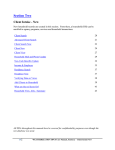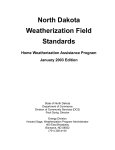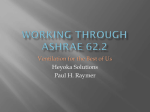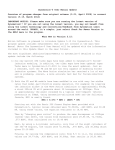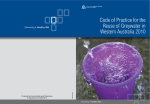Download History and Justification - Weatherization Assistance Program
Transcript
ASHRAE 62.2‐2010 National Weatherization Conference December 2011 Ventilation 62.2: Implementing the New Standard – Rick Karg, Robert Parkhurst, Paul Francisco, and Martha Benewicz 2011 DOE National Training Conference December 12‐15, 2011 1 What We Will Talk About • History and justification. • Fundamentals of ASHRAE 62.2-2010. – Alternative compliance supplement. – Infiltration credit. • • • • • Secondary requirements of 62.2-2010. Determining whole-building ventilation. Whole-building ventilation options. Measuring ventilation performance. Implementation for existing dwellings. – Background. – Implementation issues. – Installing whole-building ventilation. • Fine tuning: Wisconsin impact study. 2011 DOE National Training Conference December 12‐15, 2011 2 History and Justification 2011 DOE National Training Conference December 12‐15, 2011 Benewicz, Francisco, Karg, Parkhurst 3 1 ASHRAE 62.2‐2010 National Weatherization Conference December 2011 Standards 62-1989 and 62.2 2011 DOE National Training Conference December 12‐15, 2011 4 A Brief History of Ventilation Standards • Standard 62-1989 specified 15 CFM per person or 0.35 ACH for the building, whichever was greater. – Nothing for the materials in the space. – Standard was focused primarily on nonresidential spaces. • With Standard 119 – BTL. • Also with Standard 136 – BTLa. 2011 DOE National Training Conference December 12‐15, 2011 5 A Brief History of Ventilation Standards • 15 CFM/person originated from smell tests in the 1930s (Yaglou et al. 1936) and more or less again in 1983 (Cain et al.; Fanger et al.). – How much air did we need to not be offended by each other’s body odor? – Used bioeffluents (and 1930s hygiene) as a surrogate for IAQ. – Suggested might actually want 20 CFM/person. • Or 25 CFM for schools. • Or even 50% more for schools if the children hadn’t bathed or changed their underwear in a week. 2011 DOE National Training Conference December 12‐15, 2011 Benewicz, Francisco, Karg, Parkhurst 6 2 ASHRAE 62.2‐2010 National Weatherization Conference December 2011 A Brief History of Ventilation Standards • Standard 62.2 – First time the ventilation rate took into account pollutants other than bioeffluents. – Halved the per person part (to 7.5 CFM). – Added a per floor area part to account for these other pollutants. • Want 3 CFM per 100 square feet. • Assume you get 2 CFM per 100 square feet from infiltration – need to deliver other 1 CFM per 100 square feet with mechanical ventilation. • Can get credit for more if you measure it with a blower door. 2011 DOE National Training Conference December 12‐15, 2011 7 Wx and Ventilation • Mission statement for DOE’s low-income weatherization program: “To reduce energy costs for low-income families, particularly for the elderly, people with disabilities, and children, by improving the energy efficiency of their homes while ensuring their health and safety.” 2011 DOE National Training Conference December 12‐15, 2011 8 Wx and Ventilation • Most weatherization has used the BTL or BTLa for many years. – Some think it is a level that still provides enough air for combustion. – Some think it is enough for moisture control. – Some think it is enough for occupants. NONE of these are true 2011 DOE National Training Conference December 12‐15, 2011 Benewicz, Francisco, Karg, Parkhurst 9 3 ASHRAE 62.2‐2010 National Weatherization Conference December 2011 Weatherization and Ventilation • Misuse of 62-1989? – There has been an ongoing debate – “How tight is too tight”. – There is a widely held view that the BTL is an abuse of 62-1989. • Not intended as a “stop sealing” but rather as a “how much ventilation” standard. – Often, the BTL seems similar to a costeffective air sealing level, circumstantially. 2011 DOE National Training Conference December 12‐15, 2011 10 Weatherization and Ventilation • ~2005 – Wisconsin adopted 62.2. – Studies have shown. • Add ventilation in about ½ of homes. • Costs about $600 or so to install. • Impacts on humidity and carbon dioxide are beneficial. – Humidity lower by 4-5%. – Incidence of excessive carbon dioxide lower, especially during mild conditions. More details later 2011 DOE National Training Conference December 12‐15, 2011 11 WAP 11-06 Guidance • Health & Safety committee convened Nov. 2010. • One motivation was to clear up confusion from previous guidance. • 8 Subcommittees. • All items on the table, e.g. – – – – Radon. Appliances. Ventilation. Hazardous conditions (biological, chemical, etc.). 2011 DOE National Training Conference December 12‐15, 2011 Benewicz, Francisco, Karg, Parkhurst 12 4 ASHRAE 62.2‐2010 National Weatherization Conference December 2011 WAP 11-06 Guidance • Resulted in many new (or clarified) rules. • For ventilation. – Ventilation Subcommittee recommended to the full committee to adopt 62.2, little to no dissent. – Full committee approved 62.2 adoption. – Went through internal review. – DOE decision made to require 62.2 starting next program year. 2011 DOE National Training Conference 13 December 12‐15, 2011 Ventilation vs. Infiltration So why not just leave houses leaky, instead of spending money on both air sealing and then installing a fan? 2011 DOE National Training Conference 14 December 12‐15, 2011 250 Based on single-story, 1500 square foot house Ventilation Rate, CFM 100 150 200 CFM50 = 4000 Over-ventilation = wasted energy 50 Desired ventilation = 75 CFM 0 Under-ventilation = IAQ concerns 0 20 40 60 Outdoor Temperature, degrees F 2011 DOE National Training Conference December 12‐15, 2011 Benewicz, Francisco, Karg, Parkhurst 15 5 ASHRAE 62.2‐2010 National Weatherization Conference December 2011 250 Based on single-story, 1500 square foot house Ventilation Rate, CFM 100 150 200 CFM50 = 4000 CFM50 = 2000 0 50 Desired ventilation = 75 CFM 0 20 40 60 Outdoor Temperature, degrees F 2011 DOE National Training Conference 16 December 12‐15, 2011 250 Based on single-story, 1500 square foot house 200 CFM50 = 4000 Ventilation Rate, CFM 100 150 CFM50 = 1000 + 75 CFM fan CFM50 = 2000 50 Desired ventilation = 75 CFM 0 CFM50 = 1000 0 20 40 60 Outdoor Temperature, degrees F 2011 DOE National Training Conference December 12‐15, 2011 17 Ventilation vs. Infiltration But is it cost-effective? 2011 DOE National Training Conference December 12‐15, 2011 Benewicz, Francisco, Karg, Parkhurst 18 6 ASHRAE 62.2‐2010 National Weatherization Conference December 2011 Ventilation vs. Infiltration • Costs (of running fan). – Electricity for motor. – Conditioning of ventilation air. • Savings (from air sealing). – Less conditioning of leakage air. 2011 DOE National Training Conference 19 December 12‐15, 2011 Ventilation vs. Infiltration • Costs – example: – Assume 30 CFM fan running continuously. – Assume 11 watts. – Assume 10 cents/kWh, $1.00/therm, 90% furnace. – Electricity for motor $9.64 – Gas for heating in Chicago $22.09 $31.73 total, annual – Higher heating cost for propane or electric heat. 2011 DOE National Training Conference December 12‐15, 2011 20 Ventilation vs. Infiltration • Savings – example: – Assume starting Q50 = 3000 CFM50 – Final Q50 = 1680 CFM50 – Assume 6 people, 2000 square feet, 2-story – Leakage savings in Chicago $90.36 (Subtract costs) $31.73 Net savings $58.63 annual 2011 DOE National Training Conference December 12‐15, 2011 Benewicz, Francisco, Karg, Parkhurst 21 7 ASHRAE 62.2‐2010 National Weatherization Conference December 2011 Fundamentals of Standard ASHRAE 62.2 2011 DOE National Training Conference December 12‐15, 2011 22 Three Fundamentals of Standard • Local ventilation. – Vent moisture, etc. at the source. • Whole-building ventilation. – Dilution air lower concentrations of pollutants. • Source control. – Keep pollutants out of dwelling. • This topic is not part of this presentation. 2011 DOE National Training Conference December 12‐15, 2011 23 Local Ventilation • Exhaust the worst air in the dwelling as quickly as possible. – Bathrooms. – Kitchens. – Garages. – Crawlspaces. 2011 DOE National Training Conference December 12‐15, 2011 Benewicz, Francisco, Karg, Parkhurst 24 8 ASHRAE 62.2‐2010 National Weatherization Conference December 2011 ASHRAE 62.2 Requirements • Local exhaust fans must be installed in bathrooms and kitchen. – Bathrooms (not half bathrooms) • 50 CFM on-demand, or • 20 CFM continuous. – Kitchen • 100 CFM on-demand*, or • 5 ACH, based on kitchen volume. – 12’ x 14’ x 7.5’ kitchen requires 105 CFM. *Vented range hood required if exhaust fan flow rate is less than 5 kitchen air changes per hour. 2011 DOE National Training Conference December 12‐15, 2011 25 Whole-Building Ventilation • Dilution ventilation – bringing in enough outdoor fresh air to dilute the bad stuff already in the indoor air. • Effectiveness depends on the quality of the outdoor air and the concentration of pollutants in the indoor air. 2011 DOE National Training Conference December 12‐15, 2011 26 ASHRAE 62.2 Requirements • Whole-building ventilation: – “A mechanical exhaust system, supply system, or combination thereof shall be installed for each dwelling unit to provide whole-building ventilation. . .” – Ventilation based on the table on next slide. • These CFM requirements are for whole-building continuous ventilation Source: ASHRAE 62.2-2010, page 4 2011 DOE National Training Conference December 12‐15, 2011 Benewicz, Francisco, Karg, Parkhurst 27 9 ASHRAE 62.2‐2010 National Weatherization Conference December 2011 Whole‐Building Requirements Minimum Ventilation Air Requirements, CFM Floor Area (ft2) Bedrooms 0-1 2-3 4-5 6-7 <1500 30 45 60 75 >7 90 1501 – 3000 45 60 75 90 105 3001 – 4500 60 75 90 105 120 4501 – 6000 75 90 105 120 135 6001 – 7500 90 105 120 135 150 >7500 105 120 135 150 165 2011 DOE National Training Conference 28 ASHRAE 62.2 Requirements • Or use: Qfan = 0.01Afloor + 7.5(Nbedroom + 1) • Assumes two occupants in master bedroom and one in other bedrooms. For higher densities, increase by 7.5 CFM per occupant. • Ventilation air must come directly from outdoors. • Credit is allowed for envelope air leakage in existing homes, based on ASHRAE 1361993* A = conditioned space; “the part of the building that is capable of being thermally conditioned for the comfort of occupants.” (ASHRAE 62.2, p.3) *A Method of Determining Air Change Rates in Detached Dwellings 2011 DOE National Training Conference December 12‐15, 2011 29 ASHRAE 62.2 Requirements • The whole-building ventilation requirements of the Standard may be satisfied by intermittent operation. • In some cases, this is not a good alternative because: – May require high CFM fan flow rates. – Must provide automatic control. 2011 DOE National Training Conference December 12‐15, 2011 Benewicz, Francisco, Karg, Parkhurst 30 10 ASHRAE 62.2‐2010 National Weatherization Conference December 2011 Programmable Control A control for whole-building fans Air Flow adjustable from 40 to 100% of capacity in 16 increments for background ventilation rate. Built-in Timer programmed at installation in multiples of 5 minutes for a 12 or 24 hour cycle. Boost to full speed for 20 minutes by pressing button. Pressing again drops speed to background rate. Airetrack™ by Tamarack 2011 DOE National Training Conference December 12‐15, 2011 31 Alternative Compliance Supplement (Path) for Existing Dwellings (Appendix A of 62.2‐2010) 2011 DOE National Training Conference December 12‐15, 2011 32 Alternative Compliance Supplement • For existing dwellings only. • Provides alternative method of meeting local exhaust requirements in kitchens and bathrooms: – That do not have any existing LOCAL fan, or – Where the LOCAL fans do not meet the CFM requirement. 2011 DOE National Training Conference December 12‐15, 2011 Benewicz, Francisco, Karg, Parkhurst 33 11 ASHRAE 62.2‐2010 National Weatherization Conference December 2011 Alternative Compliance Supplement • In each room where local ventilation should be, determine deficit relative to required rate: – How much less than 50 CFM in bathrooms. – How much less than 100 CFM in kitchens. • For each room with a deficit, reduce room’s deficit by 20 CFM if that room has an operable window. 2011 DOE National Training Conference December 12‐15, 2011 34 Alternative Compliance Supplement • Add up deficits and divide by 4. • Add the result (supplement) to the initial whole-building ventilation CFM. – This becomes the new whole-building ventilation minimum requirement. Calculated before infiltration credit is subtracted 2011 DOE National Training Conference December 12‐15, 2011 35 Alternative Compliance Supplement • For existing fans used, sound and ducting requirements of 62.2 are not applicable. • Must measure flow if ratings don’t exist or duct sizing can’t be verified. – If only have rating at 0.10 in. IWC but not 0.25 in. IWC, can reduce rating at 0.10 in. IWC by 25%. 2011 DOE National Training Conference December 12‐15, 2011 Benewicz, Francisco, Karg, Parkhurst 36 12 ASHRAE 62.2‐2010 National Weatherization Conference December 2011 Alternative Compliance Supplement • Example #1: 3 BR, 1500 sq. ft. house KIT BR -50 -100 BR BT Deficit = 100+50+50 = 200 -50 Add 200/4 = 50 BR MBT Whole-house requirement = 45 + 50 = 95 CFM 2011 DOE National Training Conference 37 December 12‐15, 2011 Alternative Compliance Supplement • Example #2: 3 BR, 1500 sq. ft. house KIT BR -30 -80 BR BT Deficit = 80+30+18 = 128 -18 Add 128/4 = 32 BR MBT 32 CFM Whole-house requirement = 45 + 32 = 77 CFM 2011 DOE National Training Conference 38 December 12‐15, 2011 Alternative Compliance Supplement • Example #3 KIT -80 Add whole-house fan here BR -0 BR BT Deficit = 80+0+18 = 98 Add 98/4 ≈ 25 -18 BR MBT 32 CFM Whole-house requirement = 45 + 25 = 70 CFM 2011 DOE National Training Conference December 12‐15, 2011 Benewicz, Francisco, Karg, Parkhurst 39 13 ASHRAE 62.2‐2010 National Weatherization Conference December 2011 Infiltration Credit for Existing Dwellings 2011 DOE National Training Conference 40 December 12‐15, 2011 Infiltration Credit • Infiltration credit calculation for dwellings “built prior to the application of this standard”.1 This means existing dwellings. If: Natural Infiltration > 2A/100 Then: Infiltration credit = 0.5 (Natural Infiltration – 2A/100) A = occupiable floor area in ft2 1 ASHRAE 62.2 - 2010, page 4, for whole-building ventilation 2011 DOE National Training Conference 41 December 12‐15, 2011 Infiltration Credit • Example #4: 3 BR, 1500 sq. ft. house BR KIT BR BT Infiltration = 70 BR ½ * (70-30) = 20 MBT Whole-building requirement = 45 - 20 = 25 CFM 2011 DOE National Training Conference December 12‐15, 2011 Benewicz, Francisco, Karg, Parkhurst 42 14 ASHRAE 62.2‐2010 National Weatherization Conference December 2011 Infiltration Credit • Example #5: same house, but leakier KIT BR BR BT Infiltration = 120 BR ½ * (120-30) = 45 MBT Whole-house requirement = 45 - 45 = 0 CFM 2011 DOE National Training Conference December 12‐15, 2011 43 Determining Whole-Building Ventilation Example CFM Initial mechanical airflow = 30 Alt. compliance supplement = +15 Infiltration credit = ‐ 10 Whole‐Building Ventilation = 35 2011 DOE National Training Conference December 12‐15, 2011 44 Some Secondary Requirements of Standard 62.2 2011 DOE National Training Conference December 12‐15, 2011 Benewicz, Francisco, Karg, Parkhurst 45 15 ASHRAE 62.2‐2010 National Weatherization Conference December 2011 Some Secondary Requirements • Must prevent migration of contaminates from attached garages to the adjoining occupiable space. • Labeling and instructions to occupant. • Vent clothes dryer to outdoors. • Air inlets at least 10’ from sources of contaminants. • Sound ratings for installed fans. • Duct requirements (R-8 if outside of envelope). 2011 DOE National Training Conference December 12‐15, 2011 46 Not good! 47 Determining Whole‐ Building Ventilation 2011 DOE National Training Conference December 12‐15, 2011 Benewicz, Francisco, Karg, Parkhurst 48 16 ASHRAE 62.2‐2010 National Weatherization Conference December 2011 Methods for Sizing W-B Ventilation • The whole-building ventilation is complicated to size for an existing house because of the infiltration credit. Existing methods of sizing include: – Manual calculation forms. – DOE Standard Curricula spreadsheet. – ZipTest Pro3 for the Texas Instruments TI-89 calculator (R.J. Karg Associates). – ResVent 62.2 for the iPhone, iPad, and iPod touch (R.J. Karg Associates). – TECTITE software (The Energy Conservatory). 2011 DOE National Training Conference December 12‐15, 2011 49 Calculate with Spreadsheet 2011 DOE National Training Conference December 12‐15, 2011 50 Calculate with ZipTest Pro3 Loaded onto Texas Instruments TI-89 graphing calculator www.karg.com/software.htm Benewicz, Francisco, Karg, Parkhurst 51 17 ASHRAE 62.2‐2010 National Weatherization Conference December 2011 Calculate with ResVent 62.2 For iPhone and iPad. Must purchase from Apple app store www.karg.com/resvent622.htm 52 Whole‐Building Ventilation Options 2011 DOE National Training Conference December 12‐15, 2011 53 Ventilation System Types • System types: – Exhaust-only. • Separate exhaust fan(s). • Ducted in-line fan. – Supply-only. – Balanced system. • HRV (sensible heat recovery). • ERV (sensible and latent heat recovery). 2011 DOE National Training Conference December 12‐15, 2011 Benewicz, Francisco, Karg, Parkhurst 54 18 ASHRAE 62.2‐2010 National Weatherization Conference December 2011 Exhaust-Only Ventilation • Exhausting unit(s) only, no supply ventilation. – Exhaust fan serving one exhaust point. – In-line fan unit serving one or more exhaust points. – Creates negative pressure in building. • Pulls pollutants from garage, etc. • Backdrafting potential. – Source of supply air? 2011 DOE National Training Conference December 12‐15, 2011 55 Exhaust-Only Not appropriate for some warm climates. Source: “Proper Design of HVAC Systems for Spray Foam Homes”, April 2011, by Doug Garrett for Huntsman Corporation. Used with permission of Huntsman Corporation. 56 Panasonic WhisperGreen -Speed-compensated for static pressure - Constant run CFM from 30 to 70, switch to 80 CFM max. 57 Benewicz, Francisco, Karg, Parkhurst 19 ASHRAE 62.2‐2010 National Weatherization Conference December 2011 Bathroom or Hall Exhaust Fans Photos courtesy of Wisconsin Weatherization Program 58 Kitchen Exhaust Fans 100 CFM, or 5 ACH of kitchen volume. Venmar S1311LS range hood with 40 CFM background & 75, 160, and 270 CFM on-demand speeds. 59 Exhaust-Only, Inline Source: 62.2 User’s Manual ©2006 ASHRAE Benewicz, Francisco, Karg, Parkhurst 60 20 ASHRAE 62.2‐2010 National Weatherization Conference December 2011 Fantech Inline Exhaust Fans Fantech in‐line, 100 to 400 CFM 61 Inline Exhaust Fans Photos courtesy of Wisconsin Weatherization Program 62 Supply-Only Ventilation • Supply units only, no exhaust ventilation. – Supply fan serving one supply point. – In-line fan unit serving one or more supply points. – Creates positive pressure in building. – Not appropriate for cold climates. 2011 DOE National Training Conference December 12‐15, 2011 Benewicz, Francisco, Karg, Parkhurst 63 21 ASHRAE 62.2‐2010 National Weatherization Conference December 2011 Supply-Only Ventilation Not appropriate for cold climates. Source: “Proper Design of HVAC Systems for Spray Foam Homes”, April 2011, by Doug Garrett for Huntsman Corporation. Used with permission of Huntsman Corporation. 64 Supply Ventilation to Furnace Return Air • • • • • Ducts must be tight (or they can bring in bad air). Must have good motorized damper. Must be controlled to run even if no heat is needed. Furnace fan energy use can be high. Intake must be kept clean of yard debris and other outdoor stuff. 2011 DOE National Training Conference 65 December 12‐15, 2011 Supply Ventilation to Furnace Return Air Wrong Photos: P. Francisco Benewicz, Francisco, Karg, Parkhurst 66 22 ASHRAE 62.2‐2010 National Weatherization Conference December 2011 Don’t do this! Terminations Gone Wrong Photos: P. Francisco 67 Don’t do this! Terminations Gone Wrong Photos: P. Francisco 68 Results of Bad Terminations Different attics 69 Benewicz, Francisco, Karg, Parkhurst 23 ASHRAE 62.2‐2010 National Weatherization Conference December 2011 Balanced Ventilation • Exhaust and supply ventilation are approximately equal CFM. – Heat Recovery Ventilator (HRV) • Unit transfers sensible heat only with no humidity transfer. – Energy Recovery Ventilator (ERV) • Unit transfers sensible and humidity. 2011 DOE National Training Conference December 12‐15, 2011 70 Balanced System Source: “Proper Design of HVAC Systems for Spray Foam Homes”, April 2011, by Doug Garrett for Huntsman Corporation. Used with permission of Huntsman Corporation. 71 Heat Recovery Ventilators (HRV) Venmar HRV, inside view 2011 DOE National Training Conference December 12‐15, 2011 Benewicz, Francisco, Karg, Parkhurst 72 24 ASHRAE 62.2‐2010 National Weatherization Conference December 2011 HRV & ERV aren’t Practical When: • Energy is cheap. • House is very leaky. • There is no place for ducts. 2011 DOE National Training Conference 73 December 12‐15, 2011 Whole‐Building Ventilation Options Comparison Option Pressure Advantages Disadvantages Exhaust only Negative Simple, low‐cost installation. No energy recovery. Location of supply air uncertain. Distribution uncertain. Supply only Positive Simple, low‐cost installation. Distribution control. No energy recovery. Balanced HRV Neutral Energy recovery. Lower operating cost. Good air in/out control. Good distribution. High cost of installation. Difficult to install in existing dwellings. Balanced ERV Neutral Energy recovery. Lower operating cost. Good air in/out control. Good distribution. Humidity control. High cost of installation. Difficult to install in existing dwellings. 74 Measuring Ventilation Performance 2011 DOE National Training Conference December 12‐15, 2011 Benewicz, Francisco, Karg, Parkhurst 75 25 ASHRAE 62.2‐2010 National Weatherization Conference December 2011 Exhaust Fan Flow Meter Measurement range from 10 to 124 CFM (1 to 8 Pascals) 2011 DOE National Training Conference 76 December 12‐15, 2011 Exhaust fan flow meter use 77 Exhaust Fan Flow Meter Chart 2011 DOE National Training Conference December 12‐15, 2011 Benewicz, Francisco, Karg, Parkhurst 78 26 ASHRAE 62.2‐2010 National Weatherization Conference December 2011 Or, measure directly with the DG-700 79 Implementation for Existing Dwellings 2011 DOE National Training Conference December 12‐15, 2011 80 WI’s Experience w/ 62.2 • Why WI opted to ventilate home. • Why WI moved to 62.2. – 2004 Pilot. • The link between ventilation & combustion. – Standard testing requirements. • Ventilation Implementation issues. – Can you make it work in the field? • Fine tuning the procedures. 2011 Conference December 12‐15, 2011 Benewicz, Francisco, Karg, Parkhurst 81 27 ASHRAE 62.2‐2010 National Weatherization Conference December 2011 Implementation • Putting the issues on the table. – Implementation requirements. – How test data and information shapes decision making. – Challenges that gets solved by: • Changes to standards. • Administrative requirements. • Time and experience. 2011 DOE National Training Conference December 12‐15, 2011 82 Background 2011 DOE National Training Conference December 12‐15, 2011 83 Changing Housing Stock • Houses smaller, tighter. – Many more 1960-1970’s ranch style units coming into the program. • Don’t need much insulation. • Mechanical have usually been changed out or we will. • Issues are often health & safety: – Air quality. – Moisture management. – CO/attached garages. • Driven by service territory (housing stock). • Building Tightness Levels. – Hit or miss solutions. 2011 DOE National Training Conference December 12‐15, 2011 Benewicz, Francisco, Karg, Parkhurst 84 28 ASHRAE 62.2‐2010 National Weatherization Conference December 2011 Ventilation: “Let’s find a tool!” • 2004-2005 (July 2004-June 2005). – BTLa (based on 62-1989). • Large fans, continuous ventilation. • Learned many lessons. – Implemented in July. • back to the drawing board in August. 2011 DOE National Training Conference 85 December 12‐15, 2011 62.2-2004 Pilot: Whole-building Ventilation Rates • Information collected on exhaust flow rates. – Existing equipment . – Added or replacement equipment. – Type of combustion systems. • Blower door results. • Calculated pressure differences. 2011 DOE National Training Conference 86 December 12‐15, 2011 62.2-2004 Pilot Whole-Building Ventilation Incidence Rates Number of Buildings Requiring Ventilation 100% 100% 78.10% 80% 60% 46.90% 40% 20% 0% 62-1989 2011 DOE National Training Conference 62.2 with credit: 62.2 no credit December 12‐15, 2011 Benewicz, Francisco, Karg, Parkhurst 87 87 29 ASHRAE 62.2‐2010 National Weatherization Conference December 2011 62.2-2004 Pilot Whole-Building Ventilation Rates 250 201 Rate in CFM 200 62.2-1989 Full 62.2 150 62.2 with Infiltration Credit 114 100 70 50 0 76 69 50 50 30 Average 2011 DOE National Training Conference 28 Median Highest December 12‐15, 2011 88 62.2-2004 Pilot Projected Cost and Occurrence • Expected to: – Install ventilation in 75-80% of units. – Invest $525 in equipment. • Fan & Controls. – Install an average of 30 CFM of continuous ventilation. • Planned follow-up study for 2006. – Compare to expectation. – Fine tune the product. 2011 DOE National Training Conference December 12‐15, 2011 89 62.2-2004 Pilot Depressurization Testing • Negative pressure not significant in stick built units at final. – Gives us good information about the building. • Most of the problems are fixable. – Verifies the safety at the close of work. • Appears to be an issue with manufactured housing. – Newer mobile homes suck big time. • More later… 2011 DOE National Training Conference December 12‐15, 2011 Benewicz, Francisco, Karg, Parkhurst 90 30 ASHRAE 62.2‐2010 National Weatherization Conference December 2011 WI’s Standard Diagnostic Testing • Blower door tests. – As is, pre-test, posttest, Zone diagnostics, as needed. • Worst-case draft and spillage tests. • Depressurization limit tests. – Exhaust appliance measurements/estimates. • Ventilation. – 62.2 vent calculations. – Existing actual/estimate. • Gas range CO testing. 91 2011 DOE National Training Conference 62.2-2004 Pilot Information Collected • Exhaust flow rates. – Existing equipment. – Added or replacement equipment. – Type of combustion systems. • Blower door results. • Calculated pressure differences. 2011 DOE National Training Conference December 12‐15, 2011 92 62.2-2004 Pilot Housing Stock Drives Impact • 62 Units were included in the study. – Only 3 units were depressurized to limits above allowable levels. • The existing exhaust appliances in these 3 units had flow rates that would cause the depressurization levels, not ventilation requirements that were added to these units. • Anecdotal: these results are reflective of actual practice. – There will always be some problem buildings that need special attention. 2011 DOE National Training Conference December 12‐15, 2011 Benewicz, Francisco, Karg, Parkhurst 93 31 ASHRAE 62.2‐2010 National Weatherization Conference December 2011 62.2-2004 Pilot Conclusions • Requiring ventilation helps to provide acceptable indoor air quality in homes. • Switching to the ASHRAE 62.2 standard to determine ventilation lowers the possible impact on depressurization. • Assessments on existing equipment versus adding equipment can be done sooner in the weatherization process to smooth production. 2011 DOE National Training Conference December 12‐15, 2011 94 Implementation Issues 2011 DOE National Training Conference December 12‐15, 2011 95 Implementing Ventilation 62.2: Prescriptive Standard It doesn’t tell you how to do it! • It gives you definitions – It doesn’t give you interpretation. • Basement in or out? • It gives you the formulas and options – It doesn’t provide easy to use tools for retrofit applications. • It tells you what your end state needs to be – It doesn’t tell you how to integrate into your work flow. 2011 DOE National Training Conference December 12‐15, 2011 Benewicz, Francisco, Karg, Parkhurst 96 32 ASHRAE 62.2‐2010 National Weatherization Conference December 2011 Implementing Ventilation How Big Is the Building? Habitable Space: Building space intended for continuous human occupancy…generally living, sleeping, dining, and cooking. Not bathrooms, toilets, hallways, storage areas, closets, or utility rooms. Occupiable Space: Any enclosed space inside the pressure boundary and intended for human activities, but not limited to all habitable spaces toilets, closets, halls, storage and utility areas, and laundry areas. 2011 DOE National Training Conference 97 December 12‐15, 2011 Implementing Ventilation How Big Is the Building? • WI’s Position: – If you’d open the basement door to get a CFM50, – If the basement is finished or living space, • the basement is in. 2011 DOE National Training Conference December 12‐15, 2011 98 Implementing Ventilation Key Interest Groups • • • • • • • Trainers. Building occupants & owners. Auditor/inspectors. Crews/contractors. Local program management. State quality assurance staff. Local and state program administrators. 2011 DOE National Training Conference December 12‐15, 2011 Benewicz, Francisco, Karg, Parkhurst 99 33 ASHRAE 62.2‐2010 National Weatherization Conference December 2011 Implementing Ventilation Implementation Hurdles • New protocols & forms – Field testing. – Training & Implementation. – Quality assurance issues: • Error tolerance. • How do you measure success? • Management comfort with protocols & goals. 2011 DOE National Training Conference December 12‐15, 2011 100 Implementing Ventilation Don’t Underestimate Work-Flow Issues • Who does what tests when? • The numbers change when you’re working on the building. – Depressurization of CAZ. – Blower door CFM50 numbers. – CFM of exhaust ventilation required. 2011 DOE National Training Conference December 12‐15, 2011 101 Implementing Ventilation Work Flow Issues (continued) • When do you install whole-building ventilation? – What if the numbers change? • Start out needing 20 CFM, end up needing 70. • New controllers are very helpful. • Do you need to add make-up air? – How and where? – Current models are not very helpful. • Best case scenario is good end-state planning. 2011 DOE National Training Conference December 12‐15, 2011 Benewicz, Francisco, Karg, Parkhurst 102 34 ASHRAE 62.2‐2010 National Weatherization Conference December 2011 Implementing Ventilation Staggered Implementation • Assessed our training capacity. – Built curriculum pieces. – Determined how many sessions were required for statewide implementation. • Allowed grantees to signup for their training and implementation timetable. – Implementation required the day after training. • Trained August through December. 2011 DOE National Training Conference December 12‐15, 2011 103 Implementing Ventilation Lessons Learned • Local agencies loved staggered process – QA monitors did not love it—what? when? • Training covered basic calculations and field planning. – Primarily inspection staff. – Dialogue on work flow. • Give weatherization professionals and the tools and they will figure out both the problems and the solutions. 2011 DOE National Training Conference December 12‐15, 2011 104 Implementing Ventilation Training Lessons • Needed additional training in ventilation systems. – Installation options. – Target: inspectors, installers, subcontractors. • Needed “Why Ventilate” training for staff and customers. – Staff need to believe in ‘why’ to sell customers on ‘why’. 2011 DOE National Training Conference December 12‐15, 2011 Benewicz, Francisco, Karg, Parkhurst 105 35 ASHRAE 62.2‐2010 National Weatherization Conference December 2011 Installing Whole-Building Ventilation 2011 DOE National Training Conference December 12‐15, 2011 106 Installing Ventilation What and Where? • What type of installation? – Exhaust-only ventilation - most common option: • 58% of 1-4 unit buildings1 get ventilation – 99% of those installations are exhaust only. – 1% exhaust with passive make-up air/ 0 HRV/ERV. • Where will the fan be located? – In the attic close to the hatch? In the basement? In the bathroom? • Where will the controls be installed? – Driven by the type of installation: • Near the fan? Remote from the fan? 2011 DOE National Training Conference December 12‐15, 2011 107 Installation Issues Production Decisions When and Who? • When is the whole-building ventilation rate determined? – Building’s natural ventilation rate will changed based on air sealing. • If the building needs ventilation prior to Weatherization it will need ventilation post-weatherization. • When in the WX process is the fan installed? – Before, during, or after weatherization? • Who installs the fan? – What can crews or contractors legally do without trades? • Are they able to install the fan with an electrician hooking up the power or signing off on the installation? • Ducting to the outside? • Who makes the final adjustment of fan airflow? – Crew, electrician, or final inspector? • Trust only trained technicians. 2011 DOE National Training Conference December 12‐15, 2011 Benewicz, Francisco, Karg, Parkhurst 108 36 ASHRAE 62.2‐2010 National Weatherization Conference December 2011 Installing Ventilation Control Strategy • Setting flow rates – Continuous at a low rate 20 CFM 24/7. – Intermittent at a high rate 60CFM 20 min. every hour. – ‘Boost’ option for bathroom to serve as local exhaust and to meet wholebuilding requirement for 62.2. 2011 DOE National Training Conference December 12‐15, 2011 109 Installing Ventilation Ensuring Flow Rates • Performance Testing. – Measuring flow rates. • Maintenance of systems. – Changing filters. – Cleaning grilles. • Ducting methods. – Size and type of material. – Connections and sealing. 2011 DOE National Training Conference December 12‐15, 2011 110 Sizing Considerations Things to Avoid • Do NOT oversize exhaust. – Adding more exhaust when existing could serve purpose of meeting required 62.2. – Sizing exhaust carefully—bigger is not better. • Exercise caution in tight dwellings. – Newer mobile homes can be very tight. • Less than 900 CFM50. • High flow kitchen fans can tip the balance 2011 DOE National Training Conference December 12‐15, 2011 Benewicz, Francisco, Karg, Parkhurst 111 37 ASHRAE 62.2‐2010 National Weatherization Conference December 2011 Energy Audit Requirements • Local exhaust CFM testing vs. estimating. – Significant # perform at less than rated level. • • • • Actual measurement of the fans best data. Building dimensions. Number of occupants. Blower door test. – Infiltration credit (used at the end of the standard weatherization work). 2011 DOE National Training Conference December 12‐15, 2011 112 Energy Audit End-State Planning • Projecting the air leakage reduction. • Impact on existing natural draft appliances. • Plan for the type and location of ventilation. – Whole building. – Local exhaust mechanical installation. 2011 DOE National Training Conference December 12‐15, 2011 113 Energy Audit End-State Planning • Design the job via a work plan. – Know the depressurization, CFM50 numbers when planning work. – Assess the impact of planned work. • Key juncture sealing. • Sidewall insulation. • Bypass sealing. • Mechanical systems work-water heater, heating system. – Project what the final product should be. – Installers mock up the fan. – Use a good controller and adjust at final test. 2011 DOE National Training Conference December 12‐15, 2011 Benewicz, Francisco, Karg, Parkhurst 114 38 ASHRAE 62.2‐2010 National Weatherization Conference December 2011 On-Site Work Flow • Sub-contractor (or crew) installs the ventilation prior to the installation of other weatherization measures. – Pre-determined that you’ll be putting in one or more fans. – Prior installation allows for proper air sealing and insulation. 2011 DOE National Training Conference December 12‐15, 2011 115 On-site Work Flow Use Sophisticated Equipment • More sophisticated equipment allows for: – Adjustable flow rates. • Intermittent or continuous operation. • Controller is as important as the fan. – Fan operation is adjusted after the final blower door test. – Investment is usually cost-effective. 2011 DOE National Training Conference December 12‐15, 2011 116 On-site Work Flow Safety Testing • Natural draft combustion appliances must draft at the close of work. – Daily Tests. • When significant changes to the building are completed. • Weatherization work can change how the appliance perform. – At completion of all weatherization. • Part of the final inspection. 2011 DOE National Training Conference December 12‐15, 2011 Benewicz, Francisco, Karg, Parkhurst 117 39 ASHRAE 62.2‐2010 National Weatherization Conference December 2011 Financial Arguments • Too expensive. – Hard sell to some customers. – Defer unit if they don’t allow the installation? • Strays from mandate to “Save Energy”. • While insuring health & safety. – Electrical costs to vent; conditioned air lost. • Modeling does show costs offset by overall annual savings from air sealing. • Therm savings evaluation shows a 25 therm penalty. 2011 DOE National Training Conference December 12‐15, 2011 118 The Energy Impact of Ventilation • Electrical consumption. – Adding an electrical draw on the building. • Heat/Cool energy consumption. – Exhausting conditioned air. • CLIENT perception. – This installation is adding to my energy bill. • Contractor/crew perception. – This installation will add to your energy bill. 2011 DOE National Training Conference Energy Impact December 12‐15, 2011 119 Net Effect on Building and Cost • Costs will vary based on: – – – – Heating and Cooling Degree Days. The cost of electricity. Type and cost of heating fuel. Oil is more expensive; natural gas is less expensive. • Northern state (natural gas): – Air Sealing can save $250/year – Ventilation costs $75/year to operate • NET gain of $175 and better air quality. 2011 DOE National Training Conference December 12‐15, 2011 Benewicz, Francisco, Karg, Parkhurst 120 40 ASHRAE 62.2‐2010 National Weatherization Conference December 2011 Fine Tuning: Impact Study 2011 DOE National Training Conference December 12‐15, 2011 121 Fine Tuning: WI Refined Whole-Building Requirements • Bedrooms vs. occupant sizing. – Move to occupant based sizing. • Study indicated potential for over drying in single person households (Northern climate). • Established a threshold for whole-building ventilation. – Ventilation not required when 62.2 calculation is <15 CFM. – Building must have local exhaust. • Develop customer control package. – Guidance for what ventilation is. – What has been installed; how to use the equipment; • Control options. – Measure refusal tied to required signature on liability waiver. 2011 DOE National Training Conference December 12‐15, 2011 122 Impact of Ventilation on Weatherized Homes (2011) • Assessing the IAQ of weatherized homes with 62.2 based ventilation. – 32 weatherized homes. • Varying tightness and occupancy levels. – Remotely controlled ventilation. • Turning it on and off. • Seasonal Variation. – IAQ as measured by. • Indoor humidity. • CO2 levels in several locations in the homes. 2011 DOE National Training Conference December 12‐15, 2011 Benewicz, Francisco, Karg, Parkhurst 123 41 ASHRAE 62.2‐2010 National Weatherization Conference December 2011 Ventilation Impact Study Major Findings • Humidity. – 20% had high indoor humidity without ventilation. • Less than 50% did not have high humidity levels • CO2 Levels. – Less than 50% had high CO2 levels without ventilation • Homes with less than 30 CFM natural/occupant did not. • 62.2 mostly gets it right. – Tight homes and homes with higher occupancy had higher humidity and CO2 levels. • ASHRAE 62.2 good screening tool for need and sizing ventilation based on measured air leakage and occupancy level. 2011 DOE National Training Conference 124 December 12‐15, 2011 Ventilation Impact Study Improved IAQ in Most Homes • Indoor humidity and CO2 levels both showed statistically significant declines in most cases. • Reduction tied to ratio of ventilation rates to natural ventilation. 2011 DOE National Training Conference December 12‐15, 2011 125 Ventilation Impact Study Wet Buildings Need Other Solutions • Does not solve humidity problems with dwellings with heavy moisture load. – Still need to deal with source control and targeted local ventilation in problem dwellings. 2011 DOE National Training Conference December 12‐15, 2011 Benewicz, Francisco, Karg, Parkhurst 126 42 ASHRAE 62.2‐2010 National Weatherization Conference December 2011 Ventilation Impact Study Further Refinement Suggested • Some homes that didn’t have elevated CO2 or humidity got ventilation (based on 62.2). – Suggest limiting installations to homes where estimated natural ventilation rate is less than 30 CFM per occupant. – Would further reduce the incidence rate from 5% to 15%. • All studies available on Wisconsin’s Home Energy Plus website under Technical Reports: – http://homeenergyplus.wi.gov/section.asp?linkid=122&locid=25 2011 DOE National Training Conference December 12‐15, 2011 127 Wisconsin Ventilation Statistics 1 • Cost & occurrence rate – Single family: • 62.5%. • $504 per unit. – 2-4 Unit buildings: • 46%. • $509 per unit. – Mobile homes: • 42%. • $526 per unit. 1Based jobs completed from July 1, 2009-June 30, 2011. 2011 DOE National Training Conference December 12‐15, 2011 Benewicz, Francisco, Karg, Parkhurst 128 43













































